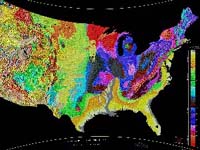All Broken Up and
Getting Carried Away
The end of the Cretaceous Period,
most scientists agree, was brought about by a doomsday asteroid or
comet colliding with the Earth. While this was disastrous for the
dinosaurs (they pretty much were wiped off the face of the planet), it
opened the door for small, fur covered, warm-blooded, milk producing
animals that gave live birth to their offspring - otherwise known as
mammals. This earned the Paleocene Period
the nickname "The Age Of Mammals". As with all of the other "age"
nicknames named for an animal type, mammals were not the only animal
type in existence, just the most dominant ones. We (yes, 'WE'
humans are mammals too) continue to be to the dominant animal type to
this day.
Throughout the last 180 million
years, including throughout the entire Paleocene
[PAY-lee-oh-seen] Period, weathering and erosion was, and
continues to be, going on.
During the Paleocene Period,
the climate of New Hampshire was warmer than it is today. This
warmer climate encouraged chemical weathering through
the interaction of water and minerals in the rocks. For instance,
geologists have long known that feldspar, one of the three main
ingredients in granite (see"The Recipe For Granite" in the Devonian Period)
and the most abundant mineral on Earth, breaks down rather easily in
the presence of water, turning into tiny grains of clay.
In addition to the warmer
climate, there is evidence that New Hampshire received more
precipitation than we do today. As a result, significant weathering and erosion , or the
carrying away of the weathered particles, occured. While
there is plenty of evidence of eroded materials being deposited
under water on the continental shelf from Paleocene times,
there is very little in the way of Paleocene deposits on land.
This lack of Paleocene deposits
is due to the tremendous scouring effects the coming continental
glaciers had on the landscape. The Pleistocene Epoch
[PLY-stoh-seen], otherwise commonly known as the Ice Age, marks the end
of the Paleocene Period
and the beginning of the Neocene Period.
|
|
| Shaping Up |
|
During
the Paleocene Period,
the processes that shaped our landscape (the Orogenies and the accretions of exotic
terranes) have all taken place. Only the wearing down of the
bedrock (by chemical and physical weathering) and its
being carryied away by water, wind and gravity (weathering and erosion ) are at
work.
By the end of the Paleocene Period,
our bedrock landscape would be close to today's, with the exception of
1.8 million years more of weathering and erosion .
However, the surface geology would look vastly different than
today's because of the upcoming Pleistocene Epoch
in the Neocene Period.
Below is a link to an interactive map produced by the United States
Geological Survey, or USGS. It is a map of the bedrock across the
United States that you can navigate around by clicking and dragging
your mouse cursor. You can also zoom in and out on specific
places. Check out the difference in the complexity between New
Hampshires bedrock and that of Nebraska or Oklahoma. Why do you
think they are so different? Just click on the image below to try
it out.

(Click on the image for a closer look.)
Image Credit:
Christopher Scotese; scotese.com
|
|